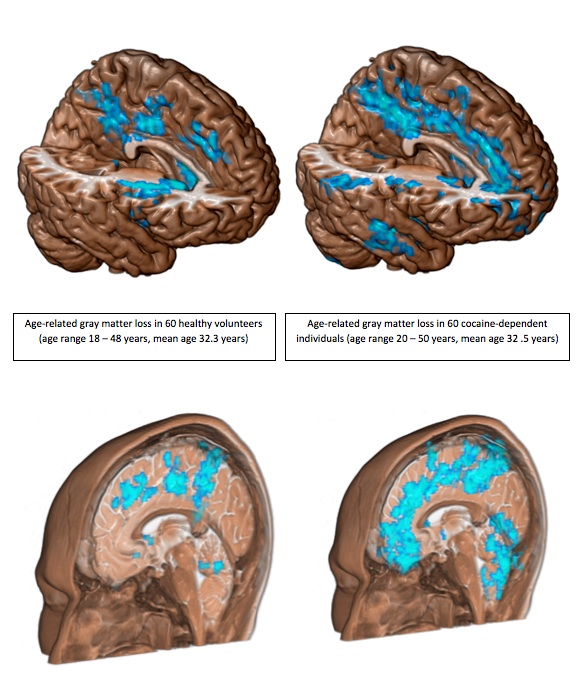Cocaine Eats Up Brain Twice as Fast as Normal Aging

Cocaine may speed up the aging of the brain, according to new research that finds that people who are addicted to the drug lose twice the brain volume each year as non-drug users.
As the brain ages, it inevitably loses gray matter, the part of brain tissue made up of neuron cell bodies. Loss of gray matter is linked with many of the signs of old age, including memory problems and other declining cognitive abilities, said study researcher Karen Ersche, a neuroscientist at the University of Cambridge.
Middle-age cocaine-dependent people show many of the signs of aging, including cognitive decline, Ersche told LiveScience. To look at the underlying cause, she and her colleagues used magnetic resonance imaging (MRI) to measure gray matter volume in 60 adults with cocaine dependence and 60 adults without substance-use troubles who were similar to the cocaine-abusing volunteers in age, gender and verbal IQ.
They found that cocaine-dependent adults showed twice the gray matter loss as their healthy counterparts: 3.08 milliliters per year in cocaine users versus 1.69 milliliters per year in people without substance abuse. [Best Games to Keep Your Brain Sharp]
The results held true even after those cocaine users who were also alcohol-addicted (16 individuals) were removed from the analysis, pointing to the drug as a cause. Although it's not possible to experiment on the human brain, animal studies suggest that cocaine-related brain atrophy may be related to oxidative stress, Ersche said. Oxidative stress is caused by the production of unstable molecules called reactive oxygen species; when the body can't remove these molecules or repair the damage they cause, disease can result.
"We have a growing number of older people seeking treatment for drug problems," Ersche said. "The Baby Boomer generation is a generation that has used more drugs than any generation before them, so they actually may suffer from an accelerated aging process, and we need to take this into account when we provide treatment."
About 21 million people use cocaine worldwide, a number that includes one-time users; In the United States, about 1 percent of the population older than 12 currently uses the drug, according to the Office of National Drug Control Policy. Nonetheless, older drug users tend to be invisible in public discourse and public policy, Ersche said. Treatment and prevention programs are skewed toward youth, she said, and little funding is available to study older adults. (The current study was funded by pharmaceutical company GlaxoSmithKline, and Ersche is supported by the Medical Research Council.)
Sign up for the Live Science daily newsletter now
Get the world’s most fascinating discoveries delivered straight to your inbox.
"We need to study the symptoms of drug addiction in older people, because they are around and they are completely neglected at the moment," Ersche said. "They are undiagnosed, and some of the symptoms may be misunderstood as dementia, for example, or depression. … My study was just the first to show there is a problem here. But it just needs attention, and it needs funding."
Ersche and her colleagues reported their work Tuesday (April 24) in the journal Molecular Psychiatry.
You can follow LiveScience senior writer Stephanie Pappas on Twitter @sipappas. Follow LiveScience for the latest in science news and discoveries on Twitter @livescience and on Facebook.

Stephanie Pappas is a contributing writer for Live Science, covering topics ranging from geoscience to archaeology to the human brain and behavior. She was previously a senior writer for Live Science but is now a freelancer based in Denver, Colorado, and regularly contributes to Scientific American and The Monitor, the monthly magazine of the American Psychological Association. Stephanie received a bachelor's degree in psychology from the University of South Carolina and a graduate certificate in science communication from the University of California, Santa Cruz.










